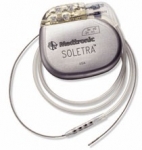Apr 27, 2006
Researchers develop thought-controlled limbs
From VRoot.org (via MSNBC)
With Pentagon support, researchers develop thought-controlled limbs. Work on artificial arms that would be controlled by the human mind is ramping up, thanks to a helping financial hand from the Defense Advanced Research Projects Agency. DARPA announced in February that it would pour $55 million into a prosthetic arm research project to be led by Johns Hopkins University’s Applied Physics Laboratory. The work will be spread among more than two dozen institutions.
23:10 Posted in Neurotechnology & neuroinformatics | Permalink | Comments (0) | Tags: Positive Technology
Mobile phone may impair your ability to make snap decisions
From textually.org
Electromagnetic radiation from your mobile phone may impair your ability to make snap decisions, such as when driving a car, an Australian study shows, reports Optus.net via Engadget Mobile and Techdirt Wireless.
"The study, which will be published in the journal Neuropsychologia found evidence of slowed reactions, on both simple reactions and more complex reactions, such as choosing a response when there is more than one alternative.
The researchers found these effects after people were exposed to electromagnetic radiation equivalent to spending 30 minutes on the phone."
... Another interesting finding of the study was that the participants showed a slight improvement in working memory, such as remembering a phone number long enough to dial it."
23:07 Posted in Wearable & mobile | Permalink | Comments (0) | Tags: Positive Technology
Deep Brain Stimulation Shows Promise in Treatment of Obsessive Compulsive Disorder

DBS has been used to treat intractable pain for several decades, and more recently, use of this technology has expanded to the FDA-approved indications for Parkinson’s disease and other movement disorders. DBS is also under investigation in the treatment of epilepsy and other debilitating neurological conditions. DBS surgery involves the placement of tiny implantable electrodes into specific parts of the brain that are functioning abnormally. These electrodes emit tiny pulses of electrical stimulation to block the abnormal activity in the brain, which causes a variety of symptoms – such as pain, tremors, movement problems; as well as obsessions, moods and anxieties associated with psychiatric disorders. The success of DBS is dependent on the surgical team’s ability to precisely pinpoint the specific brain area for stimulation. The advantage of DBS is that it is reversible, nondestructive, and can be modified by adjustment of the stimulator settings after implantation.
This study was conducted with Institutional Review Board (IRB) and Food and Drug Administration (FDA) Investigational Device Exemptions (IDE) approval. Six patients, four females and two males, with an average age of 48, were enrolled in the study from 2003 to 2005. All six patients had a history of being highly resistant to other treatments, including medication, psychotherapy, and electroconvulsive therapy (ECT). Bilateral DBS leads were implanted stereotactically in a region of the brain known as the ventral anterior internal capsule. Participants underwent standardized and detailed psychiatric, quality-of-life, and neuropsychological assessments on a regularly scheduled basis, both pre- and postsurgically.
At a minimum of six months postsurgery, four of the six patients showed a clinically significant reduction in depression severity of 50 percent or greater on the Montgomery-Asberg Depression Rating Scale. Quality-of-life measures improved as well, and patients showed progressive improvements in mood and functioning over time. One patient experienced persistent occipital pain that was alleviated with repositioning of a subcutaneous connector wire.
22:58 Posted in Neurotechnology & neuroinformatics | Permalink | Comments (0) | Tags: Positive Technology
Your Thoughts Are Your Password
17:50 Posted in Brain-computer interface | Permalink | Comments (0) | Tags: Positive Technology
Apr 26, 2006
Neural interfaces for gaming
Via VRoot
Mercurynews reports that at least two start-ups have developed technology that monitors a player's brain waves and uses the signals to control the action in games. They hope it will enable game creators to immerse players in imaginary worlds that they can control with their thoughts instead of their hands.
San Jose's NeuroSky has been testing prototypes of its system that uses a sensor-laden headband to monitor brain waves, and then uses the signals to control the interaction in video games. They hope that such games are just the beginning of a mind-machine interface with many different applications.

Read the full story
22:47 Posted in Brain-computer interface | Permalink | Comments (0) | Tags: Positive Technology
Idearium
22:31 | Permalink | Comments (0) | Tags: Positive Technology
Simulator Allows Doctors To Experience Heart Failure
Doctors and nurses who treat heart-failure patients get a chance to feel and experience what heart failure is really like.
Symptoms of heart failure include difficulty breathing, feeling tired, heart palpitations and tightness in the chest.
Doctors and nurses are placed inside Heart FXPod [<http://www.heartfxpod.com/>], created for Astra-Zeneca, which simulates what it is like for their patients.
They use the pedals to walk like a heart-failure patients and use headphones to be trapped in the patient's world
The doctors and nurses are strapped in a pneumatic vest that inflates and suddenly makes it difficult for them to breathe.
It is virtual reality, but it is a little more real than some might like.
"Severe chest tightness. So now I know what my patients go through," said Dr. Siva Srinivasan, of Thomas Jefferson University Hospital.
Srinivason said that after the simulator, he might treat his patients differently.
The Heart FXPod is a multi-sensory interactive simulation that leaves you with no doubt what it's like when your heart fails to provide enough oxygen and blood flow to your body.
If someone trying the pod gets scared they have the ability to stop it.
Dr. Paul Mather directs the Advanced Heart Failure Center at the Jefferson Heart Institute.
"Everyone has sympathy towards other human beings. I think that's part of our human element. But empathy, where you can actually feel what another person is going through as opposed to just feeling sorry for them, is different. I think if we can marry that feeling to the science of medicine, it will make for a better health care provider," Mather said.
Mather said that about 15 years ago, heart failure was a death sentence. Now, doctors can help it regress and patients can often end up living good lives.
15:08 Posted in Cybertherapy | Permalink | Comments (0) | Tags: Positive Technology
Apr 25, 2006
Is technology changing our brains?
From Smart Mobs
Neuro-biologist Susan Greenfield asked this interesting question:
" In just a couple of decades, we have slipped away from a culture based essentially on words to one based essentially on images, or pictures. This is probably one of the great shifts in the story of modern humans but we take it almost for granted.There can be little doubt that the structures, never mind the surface form, of the English language are changing fast.
The process of traditional book-reading, which involves following an author through a series of interconnected steps in a logical fashion. We read other narratives and compare them, and so "build up a conceptual framework that enables us to evaluate further journeys... One might argue that this is the basis of education ... Traditional education, she says, enables us to "turn information into knowledge."
Put like that, it is obvious where her worries lie. The flickering up and flashing away again of multimedia images do not allow those connections , and therefore the context, to build up. ...
23:40 Posted in Persuasive technology | Permalink | Comments (0) | Tags: Positive Technology
Text messaging in psychotherapy
From Smart Mobs
Instant messaging, favored by chatting teens and office gossips, is a growing tool for therapists counseling people on everything from smoking cessation to sexual-abuse trauma, reports the Pioneer Press.
Proponents say the text-based conversations are appealing because they're fast and anonymous — users can log onto a number of online services and connect with therapists who know them only by screen names. But many in the mental-health community say the format is too impersonal for effective treatment and should be only an adjunct to face-to-face counseling.... Text messaging, critics say, doesn't allow therapists to pick up on important visual cues to a patient's true state of mind.
"What one gleans as a psychiatrist in a clinical assessment is not just from the words one says but from the emotions," says Paul Appelbaum, a psychiatry professor at Columbia University and past president of the American Psychiatric Association. He says doctors need to assess the way a person walks, sits, smiles or tears up.
23:38 Posted in Cybertherapy | Permalink | Comments (0) | Tags: Positive Technology
Toward brain correlates of natural behavior: fMRI during violent video games
Toward brain correlates of natural behavior: fMRI during violent video games.
Hum Brain Mapp. 2006 Apr 20;
Authors: Mathiak K, Weber R
Modern video games represent highly advanced virtual reality simulations and often contain virtual violence. In a significant amount of young males, playing video games is a quotidian activity, making it an almost natural behavior. Recordings of brain activation with functional magnetic resonance imaging (fMRI) during gameplay may reflect neuronal correlates of real-life behavior. We recorded 13 experienced gamers (18-26 years; average 14 hrs/week playing) while playing a violent first-person shooter game (a violent computer game played in self-perspective) by means of distortion and dephasing reduced fMRI (3 T; single-shot triple-echo echo-planar imaging [EPI]). Content analysis of the video and sound with 100 ms time resolution achieved relevant behavioral variables. These variables explained significant signal variance across large distributed networks. Occurrence of violent scenes revealed significant neuronal correlates in an event-related design. Activation of dorsal and deactivation of rostral anterior cingulate and amygdala characterized the mid-frontal pattern related to virtual violence. Statistics and effect sizes can be considered large at these areas. Optimized imaging strategies allowed for single-subject and for single-trial analysis with good image quality at basal brain structures. We propose that virtual environments can be used to study neuronal processes involved in semi-naturalistic behavior as determined by content analysis. Importantly, the activation pattern reflects brain-environment interactions rather than stimulus responses as observed in classical experimental designs. We relate our findings to the general discussion on social effects of playing first-person shooter games. Hum. Brain Mapping 2006. (c) 2006 Wiley-Liss, Inc.
23:35 Posted in Cybertherapy | Permalink | Comments (0) | Tags: Positive Technology
VRoot.org -: Neural Interfaces: Scientists Probe the Use of the Tongue
PENSACOLA, Fla. - In their quest to create the super warrior of the future, some military researchers aren't focusing on organs like muscles or hearts. They're looking at tongues. By routing signals from helmet-mounted cameras, sonar and other equipment through the tongue to the brain, they hope to give elite soldiers superhuman senses similar to owls, snakes and fish.
23:27 Posted in Neurotechnology & neuroinformatics | Permalink | Comments (0) | Tags: Positive Technology
Video introducing eyetracking
23:24 Posted in Research tools | Permalink | Comments (0) | Tags: Positive Technology
Transcranial direct current stimulation
From New Scientist
It sounds like quackery, but it's not. A growing body of evidence suggests that passing a small electric current through your head can have a profound effect on the way your brain works. Called transcranial direct current stimulation (tDCS), the technique has already been shown to boost verbal and motor skills and to improve learning and memory in healthy people - making fully-functioning brains work even better. It is also showing promise as a therapy to cure migraine ...
Read the full article
23:20 Posted in Research tools | Permalink | Comments (0) | Tags: Positive Technology
Neuroelectronics
Via Mind Hacks

The New Atlantis has a comprehensive article on 'neuroelectronics' - the science of interfacing digital components with neural wetware. From the article:
The potential merging of mind and machine thrills, frightens, and intrigues us. For decades, experiments at the border between brains and electronics have led to sensationalistic media coverage, vivid science fiction portrayals, and dreams of cyborgs and bionic men. But recently, this area of science has seen remarkable advances—from robotic limbs controlled directly by brain activity, to brain implants that alter the mood of the depressed, to rats steered by remote control. Adam Keiper explores the peculiar history and present directions of this research, and considers the challenges of staying human in the age of neuroelectronics.
23:11 Posted in Neurotechnology & neuroinformatics | Permalink | Comments (0) | Tags: Positive Technology
Takeluma sonic alphabet

[pcho.net & pcho.net (avi, 13mb)]
23:02 Posted in Cyberart | Permalink | Comments (0) | Tags: Positive Technology
Games for Health Day
Davidson Executive Conference Center 3415 South Figueroa Street :: Los Angeles, California 90089
The Games for Health Project, Robert Wood Johnson Foundation, TATRC, and USC’s Annenberg School for Communication & Institute for Creative Technologies invite you to join us on May 9 for a full-day event devoted to the use of games and game technologies in health and healthcare, including an evening reception.
This one-day event, just before the opening of the Electronic Entertainment Expo will bring together researchers, game developers, and health & healthcare professionals for a series of talks devoted to how games and game technologies are addressing critical health & healthcare issues.
Talks will focus on:
• Health messaging using games
• Combat & emergency medicine
• Psychotherapy and Post Traumatic Stress Disorder
• Pain Distraction & Anxiety
• Cancer treatment
• Disease management
• Coping with family ailments
• Cognitive health
• Off-the-Shelf consumer health & exergaming titles
22:57 Posted in Positive Technology events | Permalink | Comments (0) | Tags: Positive Technology
Humanlike robots
Via the Presence Listserv
 Japan boasts the most advanced humanoid robots in the world, represented by Honda's Asimo and other bipedal machines. They are expected to eventually pitch in as the workforce shrinks amid the dwindling and aging population. But why build a robot with pigmented silicone skin, smooth gestures and even makeup? To Repliee's creator, Hiroshi Ishiguro, the answer is simple: "Android science."
Japan boasts the most advanced humanoid robots in the world, represented by Honda's Asimo and other bipedal machines. They are expected to eventually pitch in as the workforce shrinks amid the dwindling and aging population. But why build a robot with pigmented silicone skin, smooth gestures and even makeup? To Repliee's creator, Hiroshi Ishiguro, the answer is simple: "Android science."
Read the full story from Scientific American
22:45 Posted in AI & robotics | Permalink | Comments (0) | Tags: Positive Technology
Apr 22, 2006
Neuromarketing: Brain Fitness Concept Challenged
13:07 Posted in Brain training & cognitive enhancement | Permalink | Comments (0) | Tags: Positive Technology
A website that predicts your thoughts
From Cognitive Daily
There is a website that claims to predict with 98 percent accuracy what site visitors would be thinking after a short quiz.
I tried the game and it worked!
Then I looked for other mind-readers, and I found several versions:
there is even a website that offers different Flash-based customizations of the mind reader
12:47 Posted in Cyberart | Permalink | Comments (0) | Tags: Positive Technology
Apr 21, 2006
The mood of your blog
Via Smart Mobs (New Scientist)
New Scientist has an article about a software called MoodViews that tracks mood swings across the 'blogosphere' and pinpoints the events behind them. Moodviews was created by Gilad Mishne and colleagues at Amsterdam University, The Netherlands. At present, MoodViews consists of three components, each offering a different view of global mood levels, the aggregate across all postings of the various moods:
- Moodgrapher tracks the global mood levels,
- Moodteller predicts them, and
- Moodsignals helps in understanding the underlying reasons for mood changes.

From the MoodViews website:
"Check out the impact of global events on global moods. Find out whether it is true that people drink more during the weekend. Observe states-of-mind with a cyclic nature; e.g., people feel energetic in the mornings and relaxed in the evening"
19:10 Posted in Emotional computing | Permalink | Comments (0) | Tags: Positive Technology







